As the St Jude’s Smith Secondary Campus became a bustling exhibition for the annual Science Day, there were some new demonstrators delighted to be part of the much anticipated event. For the first time in the exhibitions’ nine-year history, St Jude’s graduates now teaching at under-resourced government schools as part of the Beyond St Jude’s program, brought their students to demonstrate their hard work.
This collaboration is one of the ways our graduates are giving back to the community through their Community Service Year before going on to higher education.
Njiro Secondary School student, Emmanuel John, presented an impressive environmentally friendly car powered by solar panels and a remote control, with the help of his teacher and St Jude’s graduate, Nembris.
“The direction of the car is created through positive and negative charges. This car has many advantages as it can be sent into remote areas where humans can’t go. They can control it from a distance. It can also be used in our National Parks to protect them and replace cars that are using fuel,” Emmanuel John proudly informed a crowd of students.
This entry caught the eye of the exhibition judges too, with Emmanuel’s project winning the inaugural government school category and Emmanuel receiving a donation to help expand his idea.
But the judges job didn’t stop there. The annual exhibition has traditionally been the birthplace of some of East Africa’s most prominent youth innovations and this year did not disappoint.
“We have had lots of success in our Science Department on a national level and I expect we can have more. Science is growing at the school. We placed 1st and 2nd in the country over the last two years in Tanzania’s Young Scientist Competition. Students are doing projects from the topics they are studying in class,” Acting Science Deputy, Elibariki, explained while judging the projects.
The competition was fierce in the main exhibition categories, with many lab-coated students focusing on environmentally friendly innovations.
Form 4 students, John and Steven, were the overall winners with their creation of a digital home optimization system that works as a wireless security system.
“We are passionate in electronics and gaming. We want to see technology advanced in Tanzania. The project includes automation, a security system and a digital system,” said John bursting with pride, as he and his team accepted their certificate in front of an audience of more than 700.
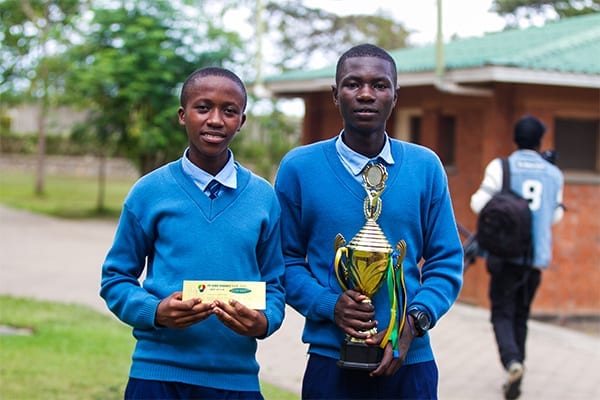
A tree planting drone, built by Form 3 students Rajab and Athuman, was named runner up with judges impressed with the practicality of the project.
“This is going to be cost effective for the Agriculture sector as we used materials like DVD cassettes to build it from scratch. We need to plant more trees to reduce the risk of global warming too,” Athuman explained while showing students his project.
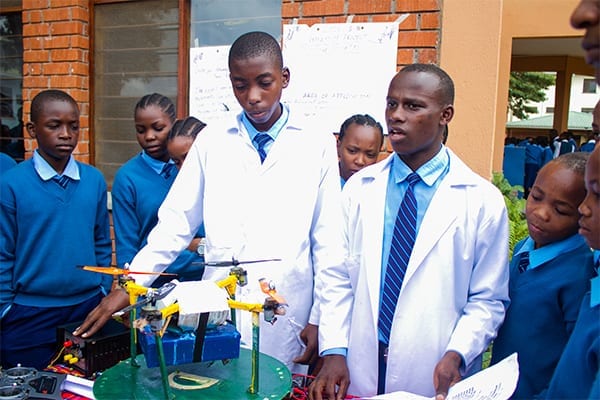
Taking third spot was Form 6 student David’s natural take on plastic, creating a biodegradable plastic alternative from natural ingredients including water, olive oil, gelatin and table salt.
“It is needed in Tanzania because plastic bags that are not decomposable have recently been banned so this is an alternative that I think could really work,” David enthused.
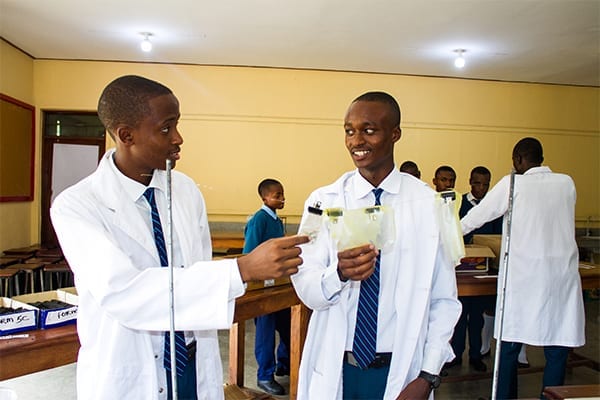
But innovation and scientific intrigue is not limited by age, with a security robot display curated by Standard 6 students another standout of the day.
“The aim of our project is making Tanzanian homes safer in an environmentally friendly way. We used wood, boxes, jugs, a bucket, solar panels and batteries. It will make an alarm if there is an intruder or if there is a fire near the home,” Standard 7 student Karen shared.
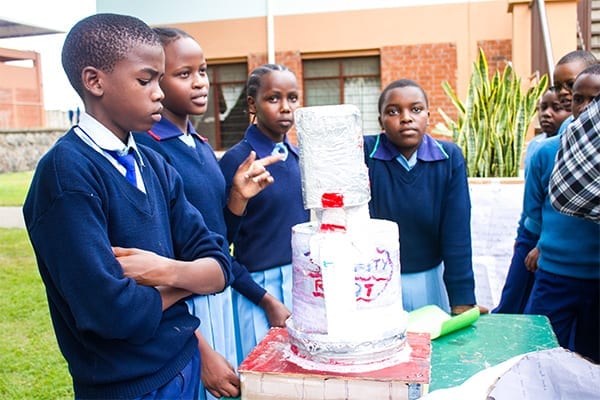
All exhibition winners now have the chance to represent St Jude’s at major events across Tanzania but the success of the day certainly spreads much further, with hundreds of students from all backgrounds and areas now inspired to study science thanks to The School of St Jude.
The 2019 Science Fair may have just discovered the next internationally acclaimed young scientist! Sponsor a student's academic scholarship and help them achieve their dreams.
Wide eyed Form 2 student, Marium, came within meters of a buffalo, a herbivore regarded as one of the most dangerous animals in Africa.
From the safety of a St Jude's school bus, she was seeing her biology and geography classes come to life in the heart of one of Tanzania's renowned national parks, the Arusha National Park.
'My heart was pumping, we had been learning in class the difference between female and male buffalo, so to be seeing them that close was something you just can't experience in the classroom. I could even see their weight, head size and type of horns, Marium excitedly shared, after the encounter.
Located just 25km from the Smith Secondary Campus, the varied national park ecosystem is literally on the doorstep for St Jude's students.
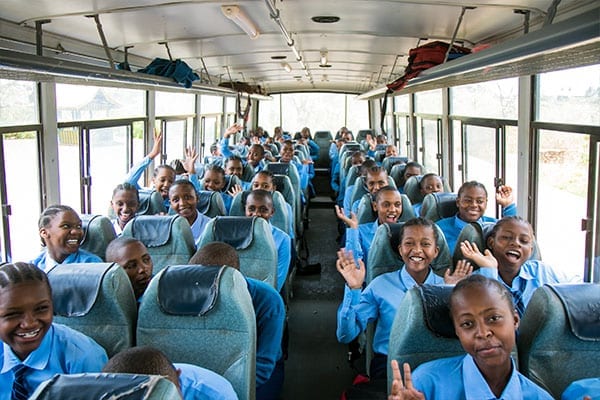
Into the field: 180 students packed out the St Jude's busses for a tour of the park.
This popular National Park is visited by keen geographers and biologists from across the world, yet many Tanzanian children don't get the chance to experience the national park that is located in their own backyard.
The School of St Jude is determined to change that, ensuring students have the opportunity to experience the unique attractions of their own country. Thanks to generous donors, all classes from primary to secondary, participate in at least one excursion trip per year.
With Mount Meru, Africa's fifth highest mountain, making for a spectacular backdrop the intrigued students quizzed the guides about the rare colubus monkeys playing in the canopies above and the grazing zebra herds.
'I did not know there are different types of zebra and we were shown them all here in Arusha National Park, Marium reflected.
The excursion was also about educating the 180 Form 2 students on the threats facing the animals of their homeland.
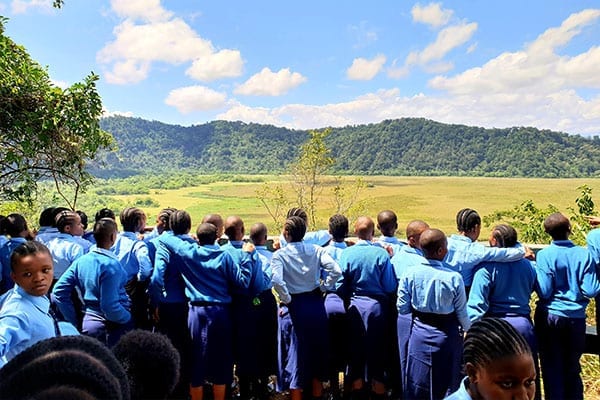
Classes come to life: Students are taught about the geography of the parks, thanks to qualified guides.
'Animal poaching has been in the news recently and coming to the park we have learnt how we can help stop that. I have learnt how animals depend on each other in the wild. Mama Gemma [referring to Founder, Gemma Sisia] was smart to make the Arusha National Park our extended backyard; I now want to protect it. Instead of just writing in the class, you can see it practically with your own eyes," Form 2 student, Andrea, explained while exploring the dense forest.
It's this experience of being able to relate theory to the real world that is the goal of taking students on this kind of excursion, Head of Geography, Mr Elimringi, said.
'In classes we can really only guide students on theory, so once we expose them to these trips they can interpret the theory in a whole new way. We find these trips often make students more interested and engaged with the subjects, he shared while watching students explore the wetlands.
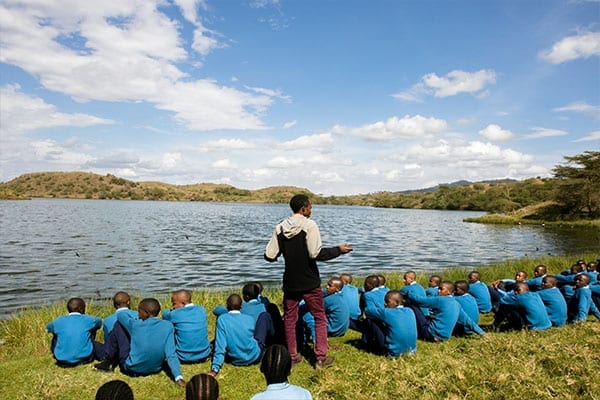
Outdoor classroom: Head of Geography, Mr Elimringi, briefs students about how their classroom learning relates to the world around them.
When it came time for Marium and her classmates to leave the ranging buffalo herd in their natural habitat, they departed having put their learning into context in one very varied and internationally-renowned classroom.
Help our students learn and explore on excursions outside the classroom. Donate today.
As the lunchtime bell rings, Mr Mcharo concludes his Form 1 physics lesson by confirming homework with students and ensuring all curriculum topics have been covered.
Then, during the short walk to his office, he begins taking calls from students' parents, stopping to answer questions from his team of teachers and replying to urgent emails on his phone.
This is the daily routine for the passionate Headmaster of St Jude’s Smith Secondary Campus, who still teaches one class per week, while working tirelessly to lead the school to the top.
“I want our school to be in Tanzania’s top five, that’s what brings me to work each morning. I am proud of the model of education we offer our students. If you visit the homes of where these students come from, you see why it is important to support them,” Mr Mcharo states, finally taking a seat in his office.

The journey to the Headmaster’s office was not a conventional one for this proud Tanzanian. After a career in telecommunications, the 2009 economic recession saw him leave his job to return to teaching, which he studied year’s earlier.
“I remember I brought my St Jude’s application to the gate and was told to leave it there. Happily, I was called for an interview for the only available role at the time, a physical education teaching role. I loved playing football but it was a big challenge for me to train younger students in the primary school. I almost gave up but now, on the 9th of June 2019, I will be ten years at the school and I have no regrets,” Mr Mcharo reflects.
After a position became available, he returned to teaching his real love, science, and his leadership potential was quickly spotted by the then academic manager.

From a Homeroom Teacher, Level Coordinator and then a Head of Department, Mr Mcharo quickly progressed up the ranks and was finally offered the top job.
“I never thought I would be Headmaster and at the start it wasn’t even a position I wanted. But I gradually became really inspired to be in the academic office, I suppose once I’d started to think in that direction it happened quicker than I even imagined. I was only Academic Deputy for a short time before I was promoted to Secondary Headmaster,” Mr Mcharo says with surprise.
Through his rise to the top office Mr Mcharo credits one project in particular for his success, Science Day, an event becoming more embedded in the school each year.
“As a teacher I feel very proud of our science fair, I designed the logo and we had our first science fair without all the technology we know today. I think that through this project I started making a name for myself, and though I now have less involvement in the details of the event, it is still one of my favourite days in the academic calendar. It made a mark in this school because it has given many students opportunities in national and international science competitions and reinforces the concept of learning by doing,” Mr Mcharo smiled, proudly holding the very first Science Day flyer.
But since taking over the top job Mr Mcharo’s legacy has grown beyond the science fair. Under his watch the school’s academic results have been markedly improving, with Mr Mcharo leading a team that are creating an environment that truly fosters students' growth.
“Our recent A Level and Form 2 results show we are making progress, but I have a lot of ambition for where I’d like us to get to. I don’t get upset for too long if things don’t initially go quite to plan as I don’t want grey hairs at this stage! Every day I do check on our statistics and make sure we are getting closer to the goal of being one of Tanzania’s top five schools.”

Plans to introduce Agriculture into the curriculum is something else that’s close to this headmaster’s heart.
“I am looking forward to introducing Agriculture as a lesson in the school, as our society depends on agriculture and this subject will give our students another good base. We have the advantage of having our school farm with a stream of water going through the campus grounds. We can do theory classes and then use our practical space.”
That forward-thinking, the diversity and unpredictable nature of the job, along with the meetings and the emails, is what continues to motivate this esteemed physics teacher.
“As a Headmaster there are more meetings than you can schedule, so many things to be aware of, but I am still a teacher at heart and being in a classroom brings flavour to my week. The students are fun and they remind me why I am here. I like the school environment, it’s frenetic and you actually interact with people. Every day I make sure I get out from behind my desk.”
“I hope in another five years we would have hit that goal of being one of Tanzania’s top five schools and maintaining that position. I’ll have students who I taught in Form 1 graduating from university studies and then I will be able to see how I have really helped change their future,” Mr Mcharo revealed.

All the while the school’s aim of fighting poverty through education is never far from Mr Mcharo’s mind and heart.
“I still visit students’ homes. I remember I went to one student’s home and I was very tired. They didn’t have a couch so I sat on the ground, looked up, and they had a torn roof. That touched me and will always stay with me.”
Help Mr Mcharo achieve his vision for The School of St Jude by making a donation.
Difficult conversations about the important issues of elephant conservation were made a whole lot easier for St Jude’s ‘Tembo club’ recently, when elephants strayed into the school campus.
“We have a situation, there are some visitors at the school grounds, they’re elephants!”
These are the words the Head Guard of Smith Secondary Campus, Joseph, never thought he would relay to school management, but this year students and staff didn’t have to go on safari to get close to the majestic animals.
The herd had in fact entered the school through a gap in the boundary wall that had succumbed to last year’s heavy rains. The temporary wire fence put in its place while repairs are underway proved an easily conquerable obstacle to these determined, yet gentle, giants.
“I first heard the sound of elephants, or tembos as we call them in Swahili, trumpeting and went to investigate. They were peacefully moving through the campus, causing no damage. It seemed they were trying to get back to the nearby Arusha National Park,” Guard Joseph explained, his surprise evident.
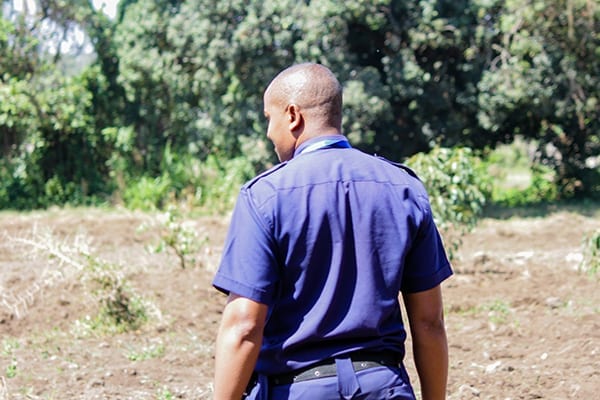
Members of the St Jude’s Tembo Club, advocates for the conservation of the elephant and rhino, were among the curious crowd of spectators and played an important role in keeping students calm, while observing the endangered species.
“I was brushing my shoes ready for Sunday mass, and I thought my eyes were playing tricks on me! There is no way I am seeing elephants on campus I thought. Tembo Club members helped keep students at a safe distance and were able to answer questions because of what we have learnt through our involvement with the club,” Form 6 student and Tembo Club member, Kevin, recalled.
With the help of park rangers and nearby residents, the elephants were herded from campus and safely arrived in the National Park two days later.
From that day the unexpected visitors have sent the St Jude’s Tembo Club into the spotlight. 30 committed students, ranging from Form 2 to Form 6 have been hard at work raising awareness about the animals that sadly face extinction as targets of ivory poachers.
“I have a passion to volunteer and make society aware of these animals. Elephants have many advantages, they are a tourist attraction and that leads to employment and being proud of our country. Many elephants are wrongly killed as many people are in search of their tusks,” Tembo Club member, Nasra, shared.
Now, thanks to the continued support of American Friends of St Jude’s and contributions from the Elephant Cooperation, the Tembo Club is set to have its biggest year yet.
With guidance from teachers with a background in animal science and biodiversity, club members have an opportunity to learn about the animals as well as the complicated relationship that has evolved living in such close proximity to people.
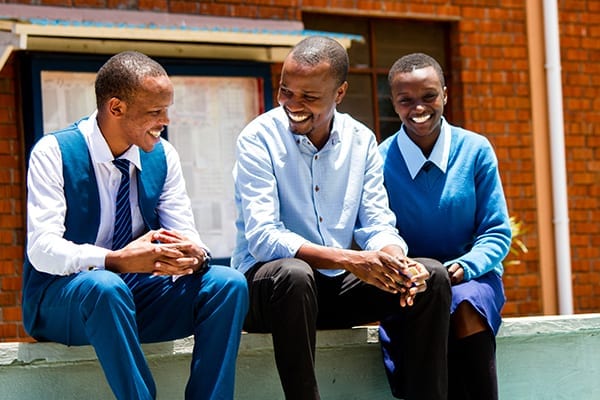
“We were able to follow up on the elephants in this area and their habits and found that years back there were elephants who roamed the area we now call Smith Secondary Campus. Elephants are smart animals so we think these were actually tracing their ancestor’s routes,” Tembo Club teacher John clarified.
The roots of the club have even branched out to the community. Catherine and Christina, St Jude’s graduates now in their Community Service Year with the Beyond St Jude’s program, held a Tembo Club meeting at a local government school which more than 40 students attended.
“Some people think that conducting the ivory black market is a good thing because they can get furniture. It’s a disappointment that these views are still held even today. Poaching means we destroy natural resources that are beneficial to us. The elephants’ visit to Smith Secondary Campus has only reinforced the importance of Tembo Club to the community,” former Tembo Club President, Christina shared.
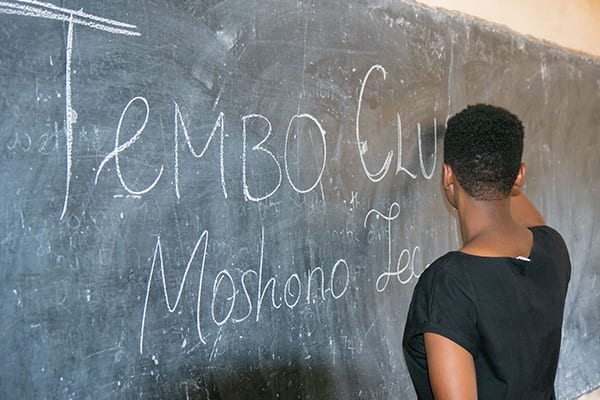
Meaning while the tembos may have left our secondary campus, the message of their conservation is travelling with them outside the school gates, helped along by a group of impassioned St Jude’s students, known as the Tembo Club.
Help our students explore their passions in extracurricular clubs by donating today.
Amid the humid and lush conditions of the school’s shamba (Kiswahili word meaning farm) and greenhouse, Form 4 student, Daudi, is digging in - preparing for his future as a possible leader in agriculture, a sector embedded into every Tanzanian’s life.
“Agriculture is the backbone of our country, around 70% of our residents are planting crops to earn money inside the country and provide for their families,” Daudi shared as he cleans cucumbers.
As well as being a necessity for many Tanzanians to sustain themselves, agriculture is also a big industry of growing importance in Tanzania’s economic growth, thanks to land and water resources, agricultural entrepreneurs and access to international markets through a major port.
The opportunity to develop both life and business skills is why every secondary student is responsible for the upkeep and improvements to the Smith Secondary Campus’ shamba during their time away from the classroom.
As farming tools sliced through the crisp morning air, Form 4 student Quinn washes up after a big morning among the bounty of fruit and vegetables.
“We are given duties each month. Today we have been weeding for the rest of the plants to grow properly. It’s a big advantage as even if you don’t choose that field of study, you can start your own farm to be sustainable. Maize and beans are very important in Tanzania, they help us minimise effects of inconsistencies of wheat production,” Quinn explained.
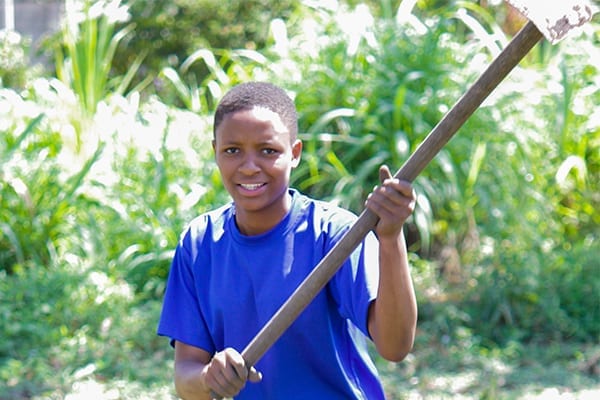
Overseen by Mr Ernest, Head of Service at Smith Secondary Campus, the self-reliance program has been hugely successful since its inception almost two years ago.
“Skills learnt from the shamba cannot be taught in the classroom. When you bring them to the farm you impart a new skill that might be very helpful in their future,” Mr Ernest beamed as he shoveled soil.
The experienced teacher has recently introduced some of the newer additions to the shamba, six healthy pigs.
“The new pig project is about having a small livestock entity for students to learn to take care of the animals. We don’t make profit from the pigs, we are loaned them from the local villages and then we pass them back to the community. We do this for the purpose of learning and it benefits the communities because we feed and take care of the pigs while we have them here,” Mr Ernest noted.
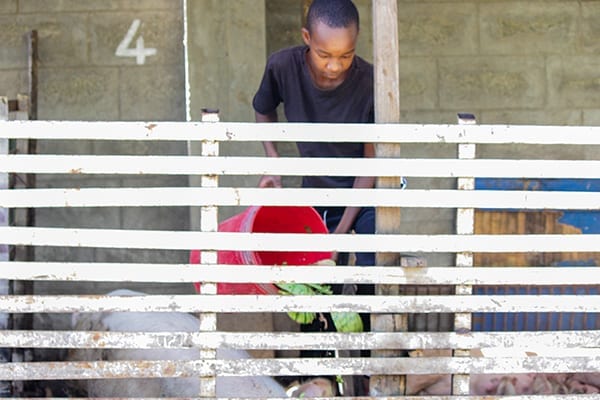
The shamba has planted the seed for students to consider a career in agriculture with six St Jude’s graduates undertaking agricultural studies at university this year.
“We have a dedicated University for Agriculture here in Tanzania. In our previous cohort of Form 6 graduates, we had one young man who is doing very well in advancing agriculture and he credits the shamba for developing his passion,” Mr Ernest proudly explains.
Eggplant, sukuma wiki (collard greens), cabbages, bananas, sweet potatoes, mangoes and tomatoes are just some of the shamba offerings that go from paddock to plate each day, feeding the hardworking school community.
With over 2,000 mouths to feed every lunch, and approximately 1,400 students who eat breakfast and dinner at the boarding houses as well, St Jude’s needs a mountain of produce and the produce from the shamba helps to contribute to this.
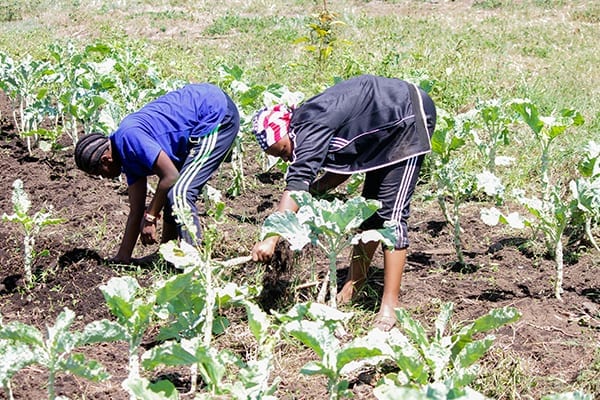
“Here at the school we have very good meals which are comprised of all the foods that make a well-balanced diet. We have proteins, vitamins and carbohydrates. Where do we get those things? A lot of it comes from our farm,” Daudi smiles as he sorts veggies for that week’s lunch.
Meaning St Jude’s students not only reap what they sow in the shamba but their hard work is ensuring the good health of our students and staff too.
The student sat still, a stethoscope on their heart, an otoscope in their ears and an ophthalmoscope waved over their eyes.
This is just part of the routine our brilliant team of health professionals undertake when assessing every child at St Jude’s from head to toe, when they visit the school each year.
They’re ensuring students can read their school blackboards and books, hear their teachers and are fit for class.
It’s no small task to adequately assess the needs of 1,800 students in just two weeks, but with decades of experience in a range of medical fields, the team saw the students in record time. The team then use their findings to refer students to medical professionals in Arusha for further assessment and support.
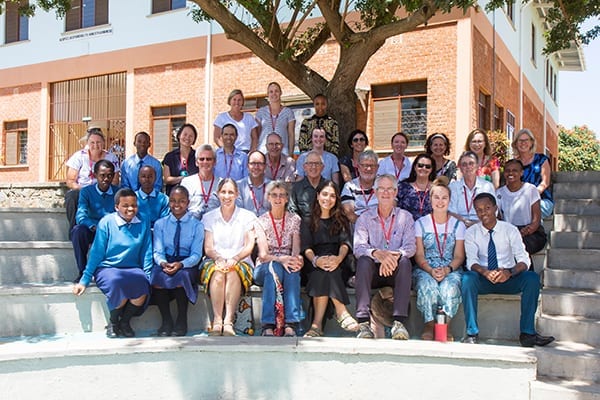
With an even wider variety of clinicians this year, there was an increased focus on ‘Orthoptics’ where students received a more in-depth assessment of their eyes and more recommendations could be made.
The multi-disciplinary team also included a wellbeing group, comprising of social workers and school psychologists, who held professional development seminars to help teachers identify and address mental health issues students may experience.
For Melbourne Physiotherapist, Jane Larkin, who co-led the Health Check program in its twelfth year, it’s about making a tangible difference during their two-week stay.
“These students come and get ten minutes of our time and it can be life changing for them. There was a student that thought she would never be able to board at St Jude’s because of her health, but now as a 17-year-old she is studying and living with her peers in boarding and absolutely thriving. Being able to facilitate that transition and for St Jude’s to source things to meet her needs, I think has made a huge difference for that student, “ Jane smiled.
Newcomer to the Health Check team this year but long-term sponsor, Kerrie, was part of the team that checked each child’s height, weight and BMI. Not only does this highlight malnourished students who can be given an increased diet, these measurements are also a requirement from the Tanzanian government.
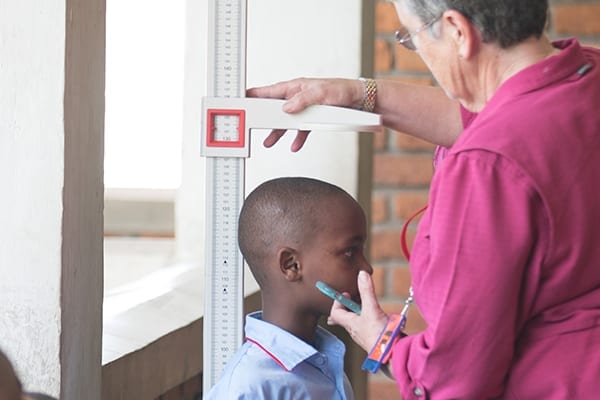
“I was impressed with how many students were really interested in finding out about their health. The older ones even wanted to know what the nutrition protocol from the World Health Organisation was for their age,” Kerrie reflected.
It was a special moment when the students whose academic scholarships Kerrie sponsors went through the checks.
“It was very emotional because I hadn’t seen the girls for six years, since I last was at the school, and it was just so rewarding to see how well they are doing, how healthy they are and how well they are getting on at school,” Kerrie gushed.
For the Sunshine Coast local it’s been a privilege watching the growth of the school and its students.
“I’ve noticed since I visited six years ago just how everyone’s health and wellbeing has improved. The students were really open and welcoming, they just wanted to chat and engage with you,” Kerrie expressed.
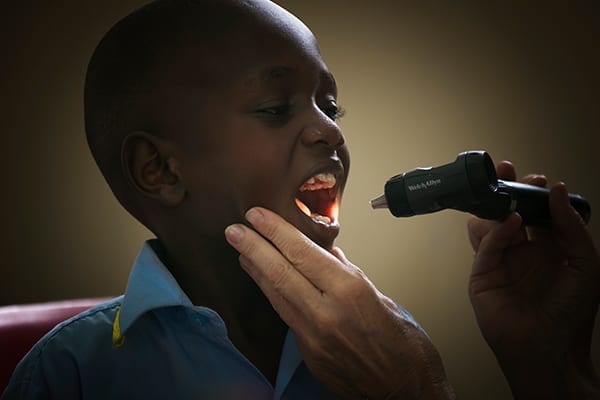
The team are vowing they’ll continue to contribute for another decade, but their ultimate goal is to help upskill local Tanzanian staff, so that more minds and bodies can be kept healthy all year round, one checkup at a time.
“For us to be able to screen these students and find local follow up here in Arusha, it can actually make a difference,” Jane smiled, proudly looking at her team.